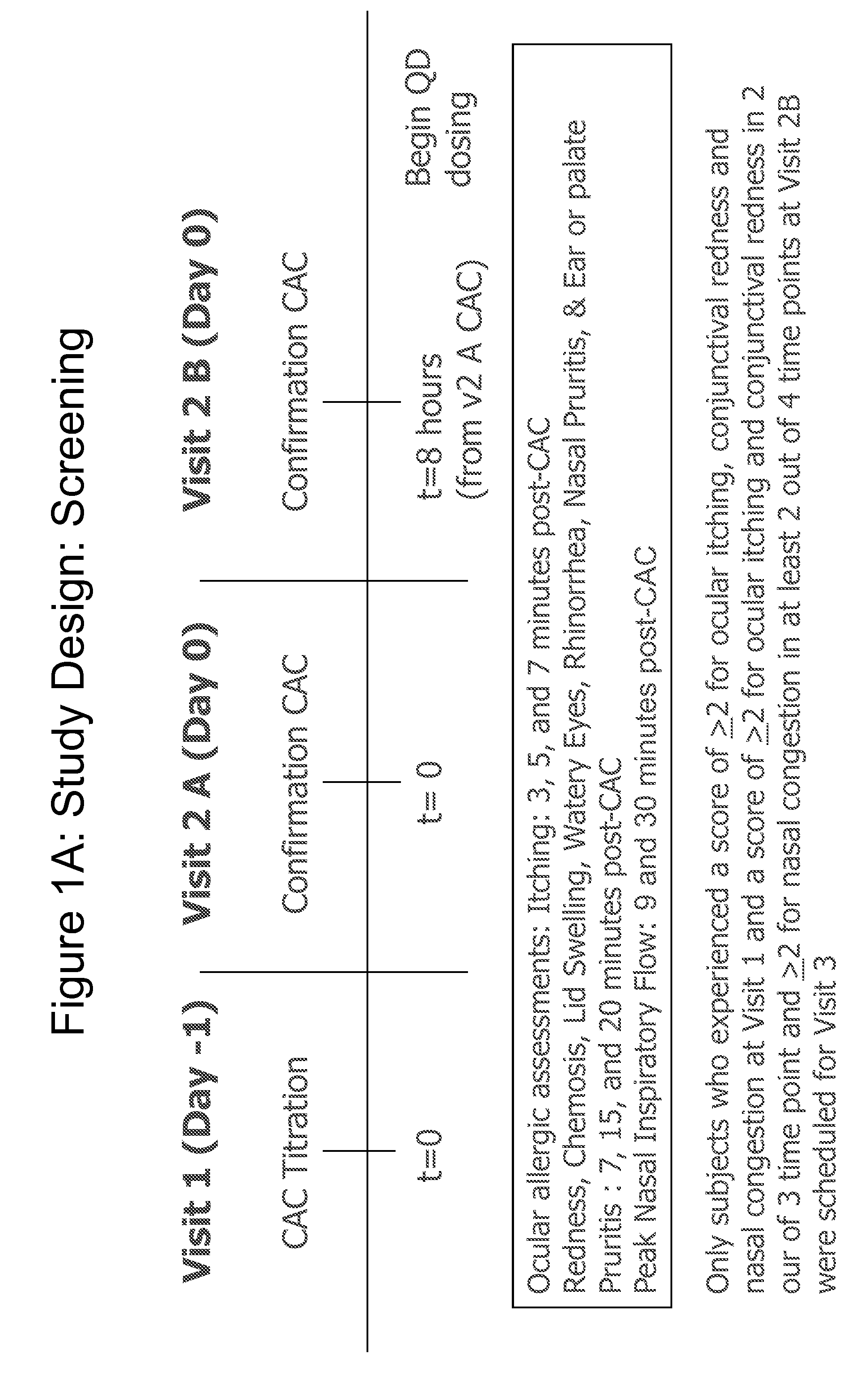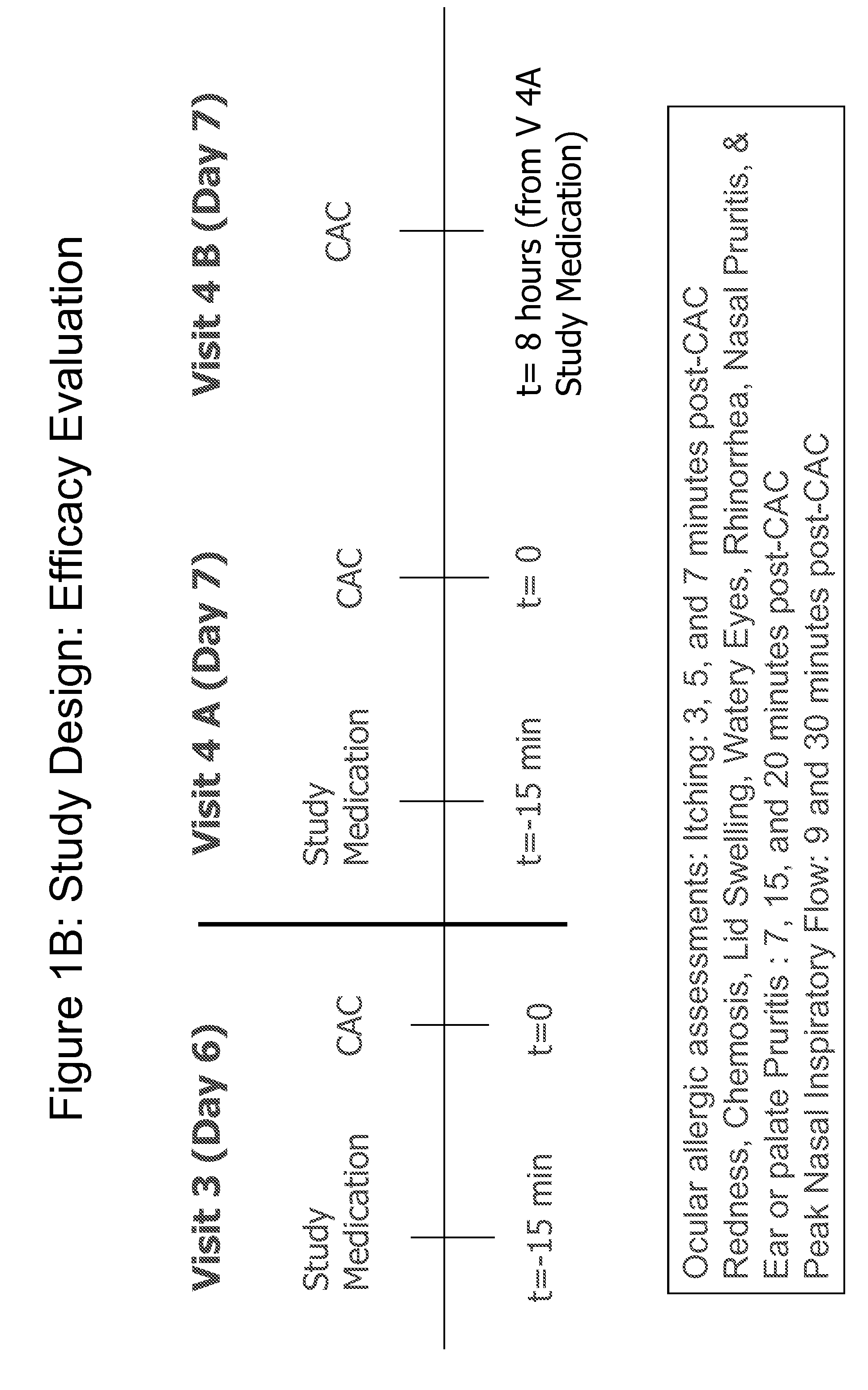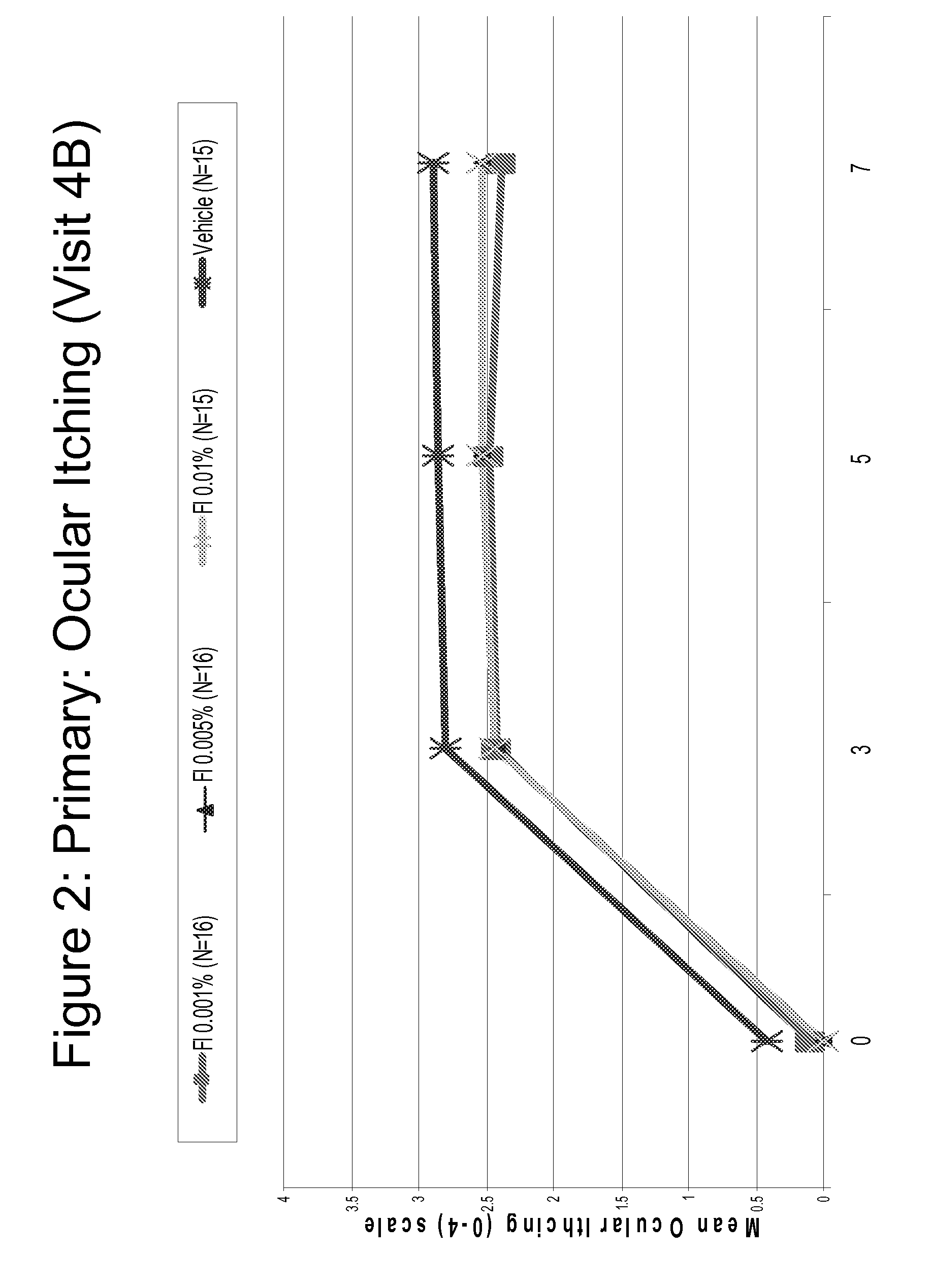[0013]The present invention provides comfortable topical ophthalmic formulations for the treatment of both acute and
late phase signs of allergic conjunctivitis as well as rhinoconjunctivitis which contain fluticasone, alone or in combination with one or more additional active agents (i.e., fluticasone alone or fluticasone combination formulations), to relieve the
signs and symptoms of allergic conjunctivitis and / or rhinoconjunctivitis, particularly ocular
itching and / or nasal symptoms (e.g., itchy, running
nose, sneezing, nasal / sinus congestion). Surprisingly, once a day dosing of the fluticasone formulations of the invention is effective to mitigate the symptoms of allergic conjunctivitis and / or rhinoconjunctivitis, particularly ocular
itching and / or nasal symptoms (e.g., itchy, running
nose, sneezing, nasal / sinus congestion). More surprisingly, the fluticasone formulations of the invention do not increase
intraocular pressure in the eye after repeated use (e.g., after 14 days in a study
population, described herein). As such the fluticasone formulations of the invention are safe for ocular use.
[0014]The ophthalmic administration of fluticasone using the formulations of the present invention may lower negative systemic side effects usually associated with nasal or
systemic administration of the
drug and may increase the
efficacy of the
drug in the eye. Accordingly, the present invention provides topical ophthalmic formulations of fluticasone that are comfortable when instilled in the eye and effective to mitigate the symptoms of ocular
allergy such as ocular
itching, redness, chemosis, lid swelling, and nasal symptoms associated with ocular allergy (e.g., stuffy, runny
nose).
[0015]In a particular embodiment, the formulations described herein provide stable formulations comprising fluticasone as the only
active agent, suitable for
ophthalmic use in a comfortable ophthalmic formulation when instilled directly in the eye. The fluticasone alone formulations (i.e., fluticasone as the only
active agent) of the invention, are surprisingly more effective in mitigating the
signs and symptoms of ocular allergy such as ocular itching, redness, chemosis, lid swelling, and nasal symptoms associated with ocular allergy / rhinoconjunctivitis, than conventional
antihistamine and / or
mast cell stabilizer agents that are typically used to treat allergic conjunctivitis and / or rhinoconjunctivitis. Antihistamines and mast
cell stabilizers do not effectively block all allergic and pro-inflammatory mediators from the mast
cell. While antihistamines and mast
cell stabilizers may effectively
mask itching, they have minimal effects on redness, tearing, swelling and
inflammation. Without intending to be bound by any theory, fluticasone can effectively halt the transcription and production of inflammatory mediators and down-regulate the production of anti-inflammatory mediators, thereby treating the
signs and symptoms of both acute and late phase allergic conjunctivitis ((i.e., the aggregate
disease).
[0018]The fluticasone combination formulations are effective in further mitigating the symptoms of ocular allergy such as ocular itching, redness, chemosis, lid swelling, and nasal symptoms associated with ocular allergy, as well as allergic rhinoconjunctivitis.
[0019]More specifically, the fluticasone combination formulations of the invention (for example without limitation, fluticasone and
cetirizine in combination) provide a comprehensive treatment benefit for both acute and late phase reactions of allergic conjunctivitis that cannot be achieved by the use of a single anti-allergic, or other
active agent, alone. As previously stated, antihistamines and mast cell stabilizers do not effectively block all allergic and pro-inflammatory mediators from the mast cell. Antihistamines and mast cell stabilizers may effectively
mask itching but they have minimal effects on redness, tearing, swelling and
inflammation. However, when an
antihistamine or
mast cell stabilizer is combined with another active agent which can halt the transcription and production of inflammatory mediators and down-regulate the production of anti-
inflammatory mediator, such as a
steroid (e.g., fluticasone), treatment of the signs and symptoms of acute and late phase allergic conjunctivitis ((i.e., the aggregate
disease) is achieved. Likewise, such fluticasone combination formulations provide a comprehensive treatment benefit for rhinoconjunctivitis that cannot be achieved by the use of a single anti-allergic, or other active agent alone, for these same reasons.
[0029]The invention also provides methods for the treatment of allergic conjunctivitis in a subject in need of such treatment by administering a fluticasone formulation of the invention (i.e., alone or in combination with one or more active ingredients) directly to the eye of a subject in need of such treatment or prevention. Preferably, the formulation of the invention is administered once a day (q.d.). In certain embodiments, the methods of the invention (i.e., administration of a formulation of the invention directly to the eye) are also effective to treat nasal symptoms associated with allergic conjunctivitis. The invention also provides methods of treating and preventing the symptoms of allergic rhinoconjunctivitis by administering a fluticasone formulation of the invention (i.e., fluticasone alone or in combination with an additional active agent such as an
antihistamine (e.g., without limitation
cetirizine or
ketotifen) or a vasoconstrictor (e.g. without limitation, naphazoline or oxymetazoline) directly to the eye of a subject in need of such treatment or prevention. By providing a treatment option in
eye drop form, the present invention will improve
quality of life in patients with allergic rhinoconjunctivitis / rhinitis (See e.g., Berger et al., Ann.
Allergy Asthma Immunol. October 95(4), 361-71 (2005)).
 Login to View More
Login to View More 


